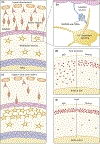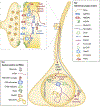Resolving the Synaptic versus Developmental Dichotomy of Autism Risk Genes
- PMID: 32209454
- PMCID: PMC7101276
- DOI: 10.1016/j.tins.2020.01.009
Resolving the Synaptic versus Developmental Dichotomy of Autism Risk Genes
Abstract
Genes that are mutated in Autism Spectrum Disorders (ASD) can be classified broadly as either synaptic or developmental. But what if this is a false distinction? A recent spate of publications has provided evidence for developmental mechanisms that rely on neural activity for proper cortical development. Conversely, a growing body of evidence indicates a role for developmental mechanisms, particularly chromatin remodeling, during learning or in response to neural activity. Here, we review these recent publications and propose a model in which genes that confer ASD risk operate in signal transduction networks critical for both cortical development and synaptic homeostasis.
Keywords: E/I balance; autism; chromatin; cortical development; genetics; genomics; neural activity; neuron migration; precision medicine; sensory integration; signal transduction; synapse.
Copyright © 2020 Elsevier Ltd. All rights reserved.
Figures



References
-
- American Psychiatric Association (2013) Neurodevelopmental Disorders In Diagnostic and Statistical Manual of Mental Disorders 0 s American Psychiatric Association
-
- Gillberg C and Fernell E (2014) Autism plus versus autism pure. J. Autism Dev. Disord 44, 3274–3276 - PubMed
Publication types
MeSH terms
Grants and funding
LinkOut - more resources
Full Text Sources

